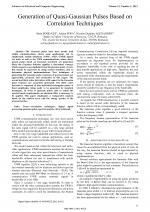| 1/2012 - 12 |
Generation of Quasi-Gaussian Pulses Based on Correlation TechniquesPOHOATA, S. |
| Extra paper information in |
| Click to see author's profile in |
| Download PDF |
Author keywords
correlation techniques, digital signal processing, gaussian pulse, spectral analysis, ultra-wideband
References keywords
pulse(12), systems(10), gaussian(5), circuits(5), ultra(4), generator(4)
Blue keywords are present in both the references section and the paper title.
About this article
Date of Publication: 2012-02-28
Volume 12, Issue 1, Year 2012, On page(s): 71 - 76
ISSN: 1582-7445, e-ISSN: 1844-7600
Digital Object Identifier: 10.4316/AECE.2012.01012
Web of Science Accession Number: 000301075000012
SCOPUS ID: 84860731128
Abstract
The Gaussian pulses have been mostly used within communications, where some applications can be emphasized: mobile telephony (GSM), where GMSK signals are used, as well as the UWB communications, where short-period pulses based on Gaussian waveform are generated. Since the Gaussian function signifies a theoretical concept, which cannot be accomplished from the physical point of view, this should be expressed by using various functions, able to determine physical implementations. New techniques of generating the Gaussian pulse responses of good precision are approached, proposed and researched in this paper. The second and third order derivatives with regard to the Gaussian pulse response are accurately generated. The third order derivates is composed of four individual rectangular pulses of fixed amplitudes, being easily to be generated by standard techniques. In order to generate pulses able to satisfy the spectral mask requirements, an adequate filter is necessary to be applied. This paper emphasizes a comparative analysis based on the relative error and the energy spectra of the proposed pulses. |
| References | | | Cited By |
Web of Science® Times Cited: 3 [View]
View record in Web of Science® [View]
View Related Records® [View]
Updated today
SCOPUS® Times Cited: 4
View record in SCOPUS® [Free preview]
View citations in SCOPUS® [Free preview]
[1] Increasing the Performance of Energy-Detection Based UWB Demodulator with a Supplementary Integration Block, POPA, A., Advances in Electrical and Computer Engineering, ISSN 1582-7445, Issue 3, Volume 12, 2012.
Digital Object Identifier: 10.4316/aece.2012.03004 [CrossRef] [Full text]
[2] A Temperature-Stable Low-Power Wide-Range CMOS Voltage Controlled Oscillator Design for Biomedical Applications, Sakka, Zied, Gargouri, Nadia, Samet, Mounir, Journal of Circuits, Systems and Computers, ISSN 0218-1266, Issue 08, Volume 29, 2020.
Digital Object Identifier: 10.1142/S0218126620501285 [CrossRef]
[3] Waveform and CMOS generator for a pulse designated for UWB European band 6–8.5 GHz, Popa, Adrian, Alexandru, Nicolae Dumitru, 2015 International Symposium on Signals, Circuits and Systems (ISSCS), ISBN 978-1-4673-7488-0, 2015.
Digital Object Identifier: 10.1109/ISSCS.2015.7203967 [CrossRef]
Disclaimer: All information displayed above was retrieved by using remote connections to respective databases. For the best user experience, we update all data by using background processes, and use caches in order to reduce the load on the servers we retrieve the information from. As we have no control on the availability of the database servers and sometimes the Internet connectivity may be affected, we do not guarantee the information is correct or complete. For the most accurate data, please always consult the database sites directly. Some external links require authentication or an institutional subscription.
Web of Science® is a registered trademark of Clarivate Analytics, Scopus® is a registered trademark of Elsevier B.V., other product names, company names, brand names, trademarks and logos are the property of their respective owners.
Faculty of Electrical Engineering and Computer Science
Stefan cel Mare University of Suceava, Romania
All rights reserved: Advances in Electrical and Computer Engineering is a registered trademark of the Stefan cel Mare University of Suceava. No part of this publication may be reproduced, stored in a retrieval system, photocopied, recorded or archived, without the written permission from the Editor. When authors submit their papers for publication, they agree that the copyright for their article be transferred to the Faculty of Electrical Engineering and Computer Science, Stefan cel Mare University of Suceava, Romania, if and only if the articles are accepted for publication. The copyright covers the exclusive rights to reproduce and distribute the article, including reprints and translations.
Permission for other use: The copyright owner's consent does not extend to copying for general distribution, for promotion, for creating new works, or for resale. Specific written permission must be obtained from the Editor for such copying. Direct linking to files hosted on this website is strictly prohibited.
Disclaimer: Whilst every effort is made by the publishers and editorial board to see that no inaccurate or misleading data, opinions or statements appear in this journal, they wish to make it clear that all information and opinions formulated in the articles, as well as linguistic accuracy, are the sole responsibility of the author.



